B i t t e r G o u r d
Momordica charantia
Sadaf Sherwani
.:TABLE OF CONTENTS:.
Scientific name:
Momordica charantia
Kingdom: Plantae
Division: Magnoliophyta
Family: Cucurbitaceae
Genus: Momordica
Species: M. charantia
Duration: annual [8]
|
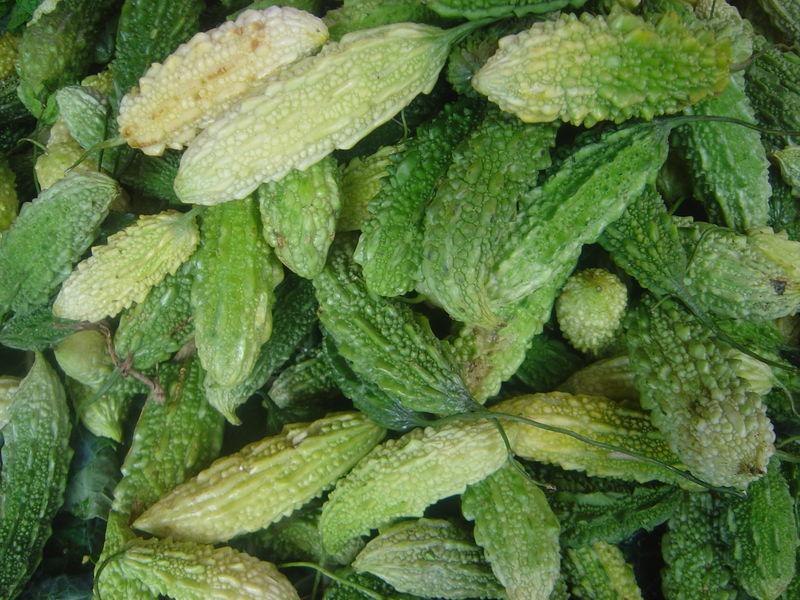
Bitter Gourd or Karela (Wikipedia.org)
|
I. Introduction
Bitter Gourd is an internationally known plant that is eaten for many of its beneficiary health effects and has been being used for a longtime throughout the world. It is known as the most bitter, edible vegetable and humans are the only mammals that have developed a taste for the bitter gourd. It is known by different names worldwide such as [1] :
- English - bitter gourd or bitter melon or balsam pear
- French - assorossie
- Spanish - balsamina
- Tagalog - ampalaya
- Bengali - korolla
- Hindi/Urdu - karela
- Japanese - nigauri or goya
- Mandarin - ku gua
- Taiwanese - ko guai
- Arabic - Hanzal
- Portuguese - melao-de-sao-caetano
- Vietnamese - kho qua
- Nepali - tito karela
This plant can be found all around Asia but the origin is unknown. It is mainly said to grow in tropical climates that include India, Pakistan, China, Caribbean, Japan, and Africa. It grows on a plant with flowers such as the one on the left.
The bitter gourd has a very bitter taste but is used in many ways culinarily including in teas, fried, and cooked with meat [2] .
|
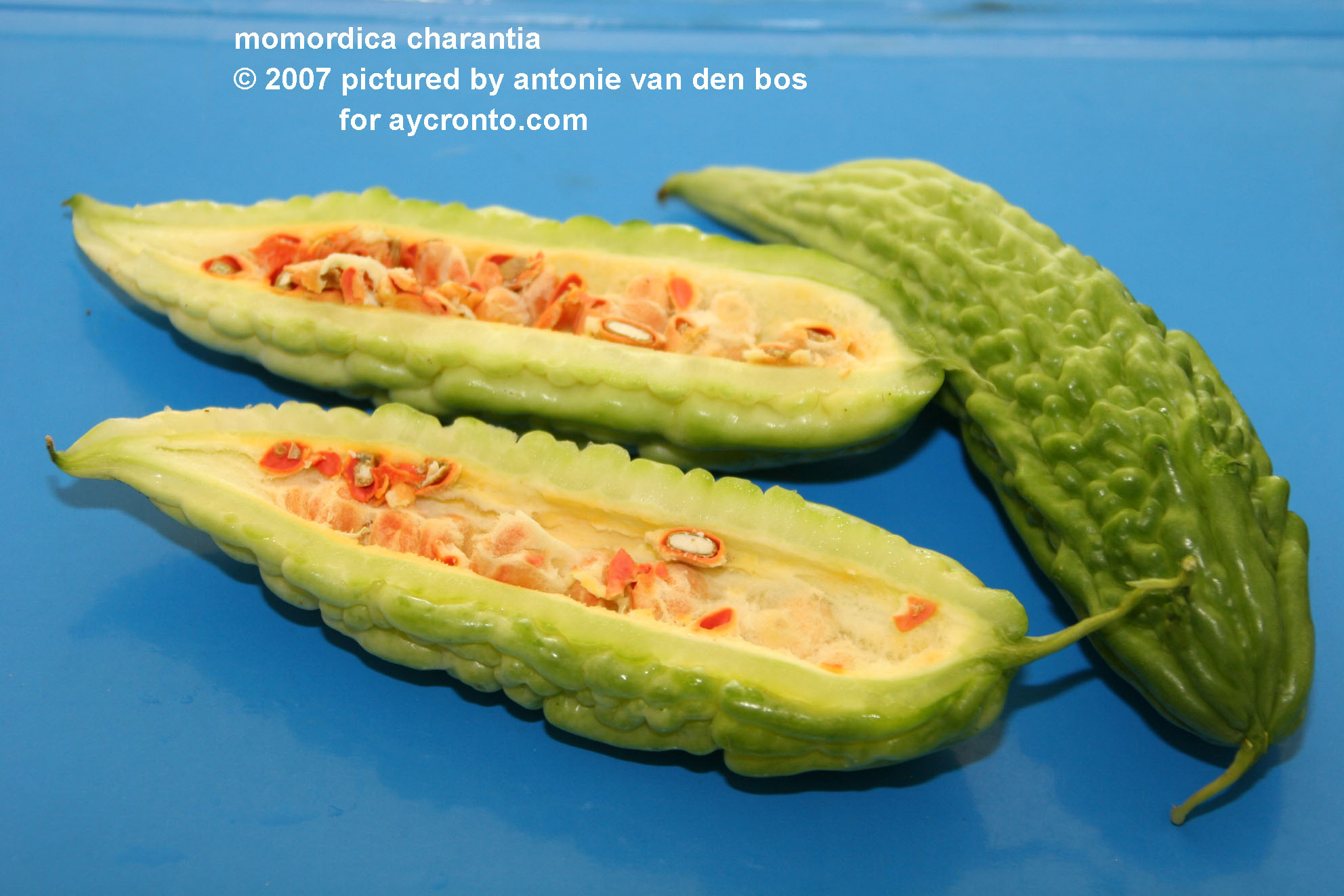 |
Permission from aycronto.com |
II. Pictures of the Bitter Gourd
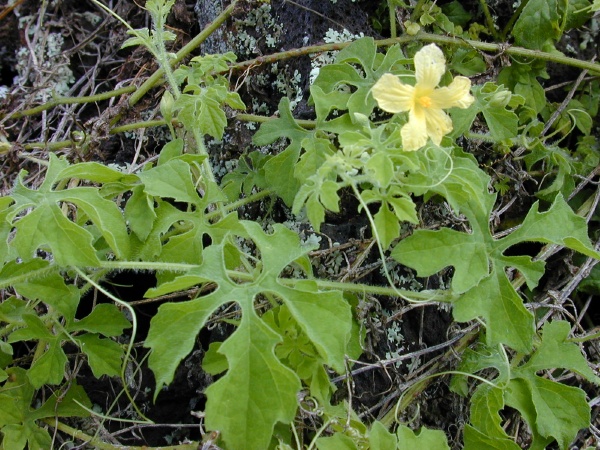

Plant Database Image from USDA.[8] .

III. Medicinal Uses
There are many medicinal and health purposes that the bitter gourd is used for such as [3] :
- to help diabetics lower their glucose levels (hypoglycemic effect)
- to stimulate digestion
- as a fever reducer
- as an anti-HIV treatment
- to help with skin problems
- to help with pregnancy
- anti-viral and anti-bacterial activity
- to reduce blood pressure
- to lower cholesterol
- to reduce inflammation
- to detoxify the body
- to expel worms [6]
- to balance horomones
- to enhance immunity
- to promote milk flow
- to prevent tumors
IV. Chemical Makeup
M. charantia has many different chemical components that help medicinally. Mainly, it is the fruit part of the bitter gourd that is useful medicinally. It is made up of many different proteins and steroids that are chemically active. One of its chemicals displays cytotoxic activity and can inhibit guanylate cyclase, which is thought to be cause of psoriasis and leukemia. Another protein has been clinically shown to serve as anti-cancerous in animals. Alpha and Beta momorcharin has been tested as anti-HIV and shows to stop virulence while the host cells were unaffected. But one of the main ingredients that serves as a hypoglycemic agent is a steroidal saponin called charantin. Charantin has a molecular weight of 578.494 [5] .
Charantin is an insulin-like chemical that can lower blood sugar and cholesterol [4] . It is found in the fruit seeds of the bitter gourd and charantin has a molecular mass of 9.7 kDa. Charantin increases glucose uptake and glycogen synthesis in the liver, muscle, and adipose tissue.
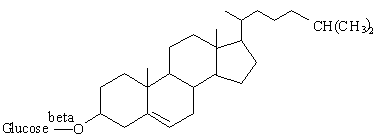 This is the structure of Charantin. Permission requested from Sabinsa Corporation from
This is the structure of Charantin. Permission requested from Sabinsa Corporation from
Momordicine is an alkaloid and is also an important part of the chemical makeup of the bitter gourd because this is the chemical responsible for the bitterness of the vegetable. It has many other important chemicals such as the glycoproteins alpha-momorcharin and beta-momorcharin. All these chemicals work together in decreasing blood sugar level. A molecule of charantin consists of aglycone, a steroid portion that is highly soluble in a non-polar solvent such as chloroform and dichloromethane [5] .
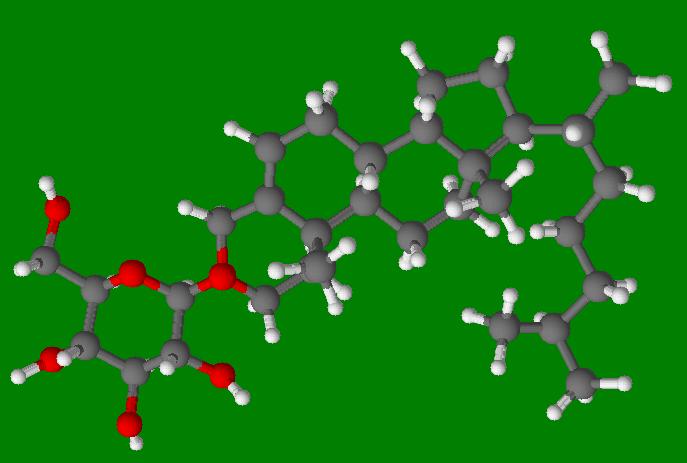 This is the 3-D structure of charantin as drawn from ChemSketch
This is the 3-D structure of charantin as drawn from ChemSketch
The bitter gourd has twice the potassium of a banana and is rich in Vitamin A and C [7] . There are always danger when intaking anything in excess. Ingestion of an excessive amounts of bitter melon juice can cause abdominal pain and diarrhea. Excessive ingestion of the seeds can cause headaches [9] , fever, and coma. Bitter melon should not be taken by pregnant women and people already with low blood sugar (hypoglycemia) should not take bitter melon because it decreases the sugar level even more [3] . But when taken in ration, the effects of the bitter gourd have been positive towards human health. Many people eat it raw, cooked [10] , boiled, in tea, and in many dishes and have been eating this for hundreds of years.
V. Isolation & Synthesis of Charantin
One procedure to identify and isolate charantin is affinity chromatography on gel which showed that it has many arginine and glutamate amino acids. The compound isolated from the seeds of the bitter gourd, charantin, was found to be 9.7 kDa . This process starts off with the crushing of bitter gourd seeds and centrifuging it to obtain a crude extract and was treated with buffers and until the turbidity reading at 280nm was less than 0.05. Some of the extract was applied to an Affi-Blue gel and fractions of the 6mL were collected at a constant rate of 1 mL/min. This was then assayed for translation-inhibitory action and the adsorbed protein that did that was dialysed against 4oC distilled water for 36 hours. This was then dissolved again in a buffer and treated to get another constant flow of 0.4 mL/min and the purified substance obtained was named charantin [12] . Mass spectroscopy was also used to determine the composition of charantin in helping to figure out its structure based on how many peaks and where and the number of carbons in the spectrum [11] .
This is an example of a Sodium dodecyl sulfate–polyacrylamide gel electrophoresis of charantin compared to other molecular weight markers.

Charantin is in column 3 as compared to the other weight markers. The top one in column 1 is phosphorylase B, with a mass of 94 kDa. The very bottom of column 2 is oxidized insulin B chain with a mass of 3.5 kDa. As you can see, charantin is in between those 2 weights and was measured to be 9.7 kDa [12] .
There is a fairly new technique for the extraction of charantin from Momordica charantia called Pressurized liquid extraction (PLE) and is done by using ethyl alcohol as the solvent. By changing the solvents, solvent flow rate, and temperature, scientists were able to achieve a more efficient way to isolate charantin from the actual fruit of the plant at an increased rate in time and a decrease to how much solvent they lost [5] . Before liquid chromatography could be performed, the charantin needed to be purified so that there were no other contaminants like chlorophyll and other sugars. The most efficient way to extract the charantin depended on the temperature and the composition of the solvents.
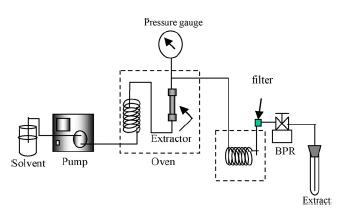 |
This is a picture of the device needed for the Pressurized Liquid Extraction taken from this journal [5] . |
So pressurized hot water is heated upto 400oC so that it is above boiling but below critical heat (where it could just decompose and destroy most the chemical structures), and it's kept in this subcritical area so that the water dielectric constant decreases which makes it possible for the compounds to be soluble. This type of PLE requires low solvent volume and a short extraction time because the solvents are heated to the critical region where they have high extraction properties.
First, a crude extract needs to be taken from the bitter gourd seeds and 5 mL of methanol-water was added to it. The mixture was centrifuged for 15 minutes. The precipitate was taken and with 5 mL methanol-water, it was centrifuged again. It was centrifuged a third time with 3 mL of hexane. After this, the mixture was dissolved in a 200 microliter chloroform-methanol mixture. This mixture was filtered through nylon membrane filter and analyzed. The flow rate of methanol-water on the extract was 1 mL/min. This was pressurized to 10 MPa and extracts were collected every 10 minutes. The percent recovery was almost above 90% with this new extraction technique [5] . Charantin is a mixture of two compounds called sitosteryl glucoside and stigmasteryl glucoside.
VI. References
[1] Healthynerd.com. "Two Cheap Insulin Alternatives for Diabetes" Oct 2007. http://www.healthynerd.com/2006/08/02/bitter-melon-prickly-pear-cactus-reduce-glucose-levels-of-type-2-diabetics/
[2] CharanteaUSA.com. "Some Observations on Hypoglycemic Activity of Momordica charantia" July 1960 Ind. Jour. Med. Res. Vol.48, No.4, pp.471-477 by V. N. Sharma, R. K. Sogani, R. B. Arora http://www1.charanteausa.com/bittermelonstudies/
[3] MDIdea.com. Bitter Gourd: Momordica charantia. Aug 2006. http://www.mdidea.com/products/herbextract/bittermelon/data.html
[4] Raintree Nutrition, Inc. "Bitter Melon" Jan 2007. http://www.rain-tree.com/bitmelon.htm
[5] Jesada Pitipanaponga, Sutawadee Chitprasertb, Motonobu Gotoc, Weena Jiratchariyakuld, Mitsuru Sasakic and Artiwan Shotipruk. "New approach for extraction of charantin from Momordica charantianext term with pressurized liquid extraction." Separation and Purification Technology Volume 52, Issue 3, January 2007, Pages 416-422.
[6] The National Bitter Melon Council. Jan 2007. http://www.bittermelon.org
[7] KillerPlants.com Plant of the Week. "Momordica charantia" http://www.killerplants.com/plant-of-the-week/20040927.asp
[8] USDA Plants Profile. "Momordica charantia" http://plants.usda.gov/java/profile?symbol=MOCH2
[9] University of Florida. "Balsam-apple" by David W. Hall, Vernon V. Vandiver, and Brent A. Sellers http://edis.ifas.ufl.edu/FW028
[10] Ayurvedic Recipe Listing. "bitter gourd" http://www.ayurbalance.com/explore_recipesindex.htm
[11] Chang, C.I. et al. "Cucurbitane-Type Triterpenoids from Momordica charantia" J. Nat. Prod. 2006, 69, 1168-1171.
[12] Parkash, A., Ng, T.B. & Tso, W.W. "Purification and characterization of charantin, a napin-like ribosome-inactivating peptide from bitter gourd (Momordica charantia) seeds." J. Peptide Res., 2002, 59, 197–202.






 This is the structure of Charantin. Permission requested from Sabinsa Corporation from
This is the structure of Charantin. Permission requested from Sabinsa Corporation from 

